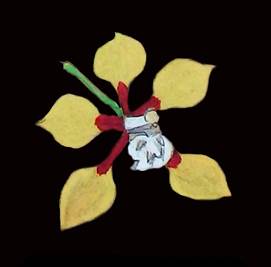Introduction
The isolated mountain range of Sierra Nevada de Santa Marta (SNSM) in northern Colombia was for a long time a dangerous place to visit due to local drug and terrorist activities. Only very recently has the situation been slowly improving allowing biological expeditions to carry out more complete inventories of plant and animal life. Isolated mountains, in general, tend to develop unique and endemic biota and the SNSM is no exception. The showy orchid species Odontoglossum naevium Lindl., and Odm. nevadense Rchb.f., for example have never been found outside of this mountain range. The genus Cyrtochilum Kunth also contributes with some unique species such as C. violaceum Dalström, and the enigmatic C. leucopterum (Rchb.f.) Dalström (Fig. 1). The latter species was originally found growing as a terrestrial plant somewhere in the “Rio Hacha province” [Provincia del Río de La Hacha] at 9000- 10,000 feet (3000-3300 m) and collected in 1852 by Luis Schlim, the half-brother of the famous orchid nursery legend Jean Linden, who later introduced this species into cultivation in Europe. It was scientifically described as Odontoglossum leucopterum Rchb.f., by Heinrich Gustav Reichenbach (1854) and later transferred to Cyrtochilum by Dalström (2001). The color of the flower is described by Schlim as white with purple-violet spots. Since the original description and introduction of “Odontoglossum leucopterum”, no living material, photographs or illustrations of fresh flowers have been seen by the authors of this paper. Leonore Bockemühl (1989) included what she believed was this species in her treatment of the genus Odontoglossum, but a comparison between the morphological details of the flowers demonstrate that aside from the coloration there are no similarities between the two taxa. The taxon interpreted as “Odm. leucopterum” by Bockemühl is in fact an undescribed species (Dalström et al. in prep.), which is not known from the SNSM region. The senior author of this paper has also been fooled by superficial appearances of a couple of recently observed species, but they both represent something else other than the true C. leucopterum and one of them is described as a new taxon here.
Taxonomic treatment
Cyrtochilum schmidt-mummii Dalström & C.Castro, sp. nov. (Fig.2 - 6)
TYPE: Colombia. Department of Magdalena: San Lorenzo, Hacienda La Victoria, Cerro Quemado “near” Santa Marta, alt. 1900 m, 12 Feb. 1962, H. Schmidt- Mumm 105 (holotype: COL-93207).
Diagnosis: Cyrtochilum schmidt-mummii is distinguished from the superficially similar C. leucopterum by having an elongate basal part of the lip with erect lateral lobes, and a trilobed front lamina with a glabrous, blunt and thickened bilobed lip callus, versus what appears to be more horizontally spreading lateral lip lobes and a densely micro-pubescent apically multifid lip callus for C. leucopterum. In a dried state, the leaves, inflorescence, sepals, petals and lip of C. schmidt-mummii show the presence of purported silica bodies (Prychid, Rudall & Gregory 2004) which are lacking in C. leucopterum.
Epiphytic herb. Pseudobulbs caespitose, ovoid, ca. 5.5 × 2 cm, surrounded basally by 4 or 5 distichous foliaceous sheaths, 3-leaved on the type illustration, which can be a misinterpretation and include the foliaceous bracts. Leaves subpetiolate, conduplicate, linear, acute to acuminate, to ca. 60 × 4.5 cm, in Schmidt-Mumm’s type illustration, to ca. 40 × 3 cm on the holotype, which can be based on foliaceous bracts. Inflorescence axillary from the base of the pseudobulb, a loosely flexuous panicle with 4 basal slightly fractiflex 2 to 5 flowered side branches, ca. 4-7 cm apart, then racemose, to ca. 54 cm long. Peduncular and floral bracts appressed, scale-like, acute, ca. 5 mm long. Pedicel with ovary 12-20 mm long. Flowers stellate, with yellow sepals and petals marked with dark brown basally, and a “clear” yellow lip and column, which has some “caramel-colored” stripes. Dorsal sepal unguiculate then broadly orbiculate and acute, ca. 12-13 x 7 mm. Lateral sepals unguiculate, then obliquely and unevenly orbiculate, apically slightly canaliculate and acute, ca. 15 × 7 mm. Petals sub-sessile, obliquely obovate apically slightly canaliculated, acute, ca.11-12 × 5 mm. Lip rigidly attached to the base of the column by a central, longitudinal fleshy keel, basally parallel with the column, with basal erect lateral lobes, then reflexed with a trilobed front-lamina with rounded lateral lobes and a broadly rounded front-lobe, 12- 13 × 7-8 mm; callus of a low central, longitudinal fleshy keel emerging from the base of the lip and extending to the base of the front-lobe, with a pair of blunt, fleshy and slightly diverging keels with a smaller fleshy angle on each side. Column clavate, straight, ventrally grooved, with a slightly thickened apical wingless part, 6-7 mm long. Anther cap campanulate, dorsally slightly lobulate, apparently whitish. Pollinarium of two obovoid, cleft/folded, pollinia on a minute stipe, on a pulvinate viscidium.
Additional Material Examined: Colombia. Department of Magdalena: Sierra Nevada de Santa Marta, collected during the Herbert H. Smith expedition 1898-1899. H. Smith 2351 (CM, K!, NY!).
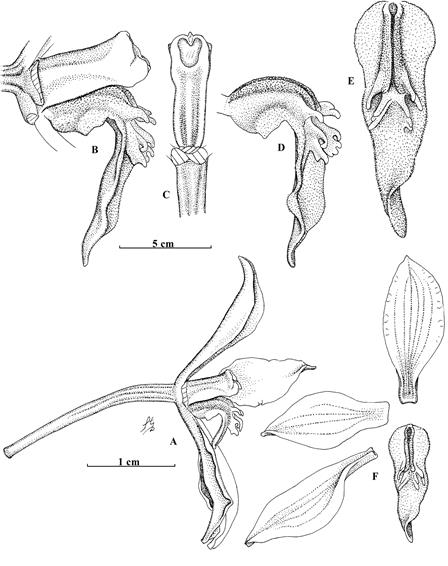
A. Flower lateral view, with right petal removed.
B. Column and lip lateral view.
C. Column ventral view.
D. Lip lateral view.
E. Lip dorsal view.
F. Dissected flower.
Drawn from J. Hanbury-Tracy 493 (K), by Stig Dalström.
Figure 1 Cyrtochilum leucopterum (Rchb.f.) Dalström.
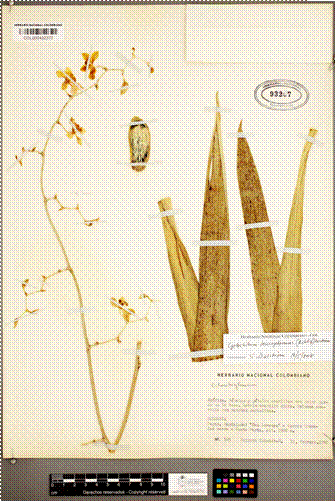
Photo by Cristian Castro.
Figure 2 Cyrtochilum schmidt-mummii Dalström & C.Castro, H. Schmidt-Mumm 105 (holotype: COL).
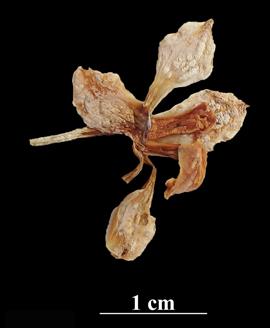
Photo by Cristian Castro.
Figure 3 Cyrtochilum schmidt-mummii Dalström & C.Castro, H. Schmidt-Mumm 105 (holotype: COL).
Distribution
Cyrtochilum schmidt-mummii is only reported from Sierra Nevada de Santa Marta in northern Colombia, growing as an epiphyte at 1900- 2000 m elevation.
Eponymy
Named in honor and memory of Helmuth Schmidt-Mumm, a German optometrist who lived in Bogota and specialized in contact lenses, and was a keen orchid enthusiast (at least until 1980). During his later years, he abandoned all his nurseries, mostly for security reasons due to local guerilla activities and his amazing collection disintegrated almost completely. During the last years of his life, Helmuth Schmidt-Mumm developed a friendship with recently passed Peter Wüllner, also a Bogota resident and an enthusiastic orchid collector and grower. Much thanks to Wüllner, his elder friend returned to the orchid world and together they managed to salvage some of the former Schmidt-Mumm collection. One of his plants represents the type of the species that now bears his name.
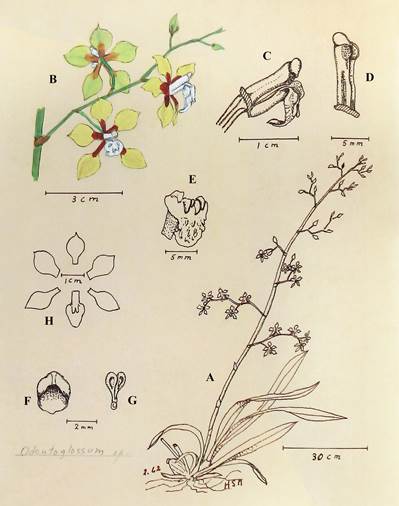
A. Plant habit.
B. Side branch with flowers.
C. column and lip lateral view.
D. Column lateral view.
E. Lip frontal-ventral view.
F. Anther cap.
G. Pollinarium.
H. Flower dissected.
Drawn from H. Schmidt-Mumm 105 by Helmuth Schmidt-Mumm, edited by Stig Dalström and published with kind permission from the President of the “Fundación Rodrigo Escobar Restrepo”.
Figure 4 Cyrtochilum schmidt-mummii Dalström & C.Castro.
Miscellaneous notes
The type illustration of Cyrtochilum schmidt-mummii was made by Helmuth Schmidt-Mumm in 1962 (Fig. 4-5) and has appeared in a book containing a brief biography of Schmidt- Mumm’s life and with numerous colored illustrations of Colombian orchid species made by Schmidt- Mumm, presumably from his private collection. It was published in 2015 on the initiative by Peter Wüllner together with Juan Felipe Posada, and funded by the Fundación Rodrigo Escobar Restrepo, Medellín, Colombia (Posada & Wüllner 2015). When the senior author of this paper was casually going through the illustrations while visiting Antonio Uribe in Bogota in 2018, his attention was caught by the drawing of a hitherto unfamiliar species labeled as “Odontoglossum sp.”. It was immediately recognized as an unusual Cyrtochilum species, and it was first believed to represent the rare and elusive C. leucopterum. Later, however, and after having erroneously determined the dried specimen at the Herbario Nacional Colombiano (COL), in Bogota, which correlates with the Schmidt-Mumm illustration, it was realized that this taxon represents a new species. After some additional research going through old files and notes, it was discovered that Herbert Huntington Smith also collected this species in the Sierra Nevada de Santa Marta region during his expedition in 1898-1901 (Ayers & Boufford 1988). Herbert Huntington Smith (1851-1919) was a devoted collector of a wide variety of natural history specimens, primarily insects, mammals, fresh water molluscs, birds, and plants. He is best known for his collections from the New World tropics where he gathered specimens in Brazil, Mexico, the West Indies, and Colombia (Ayers & Boufford 1988). After having held a position as the Curator of Invertebrate Zoology at the Carnegie Museum of Natural History in Pittsburgh for two years, he resigned and moved to Colombia together with his wife and young son in 1898. The Smith family settled in Bonda, a small town seven miles east of Santa Marta in the department of Magdalena. From Bonda, Smith made collecting trips to 19 different sites (Ayers & Boufford 1988), including the Sierra San Lorenzo. It, therefore, seems plausible that Smith may have found his plants of C. schmidt-mummii in the same general area where Helmuth Schmidt-Mumm found his plant 60 years later. Smith returned to the US together with his family in the spring of 1902 when both he and his wife were employed as assistants by the section of Botany at the Carnegie Museum where they sorted their collections into sets (Ayers & Boufford 1988). After having accessioned one set of approximately 2500 unidentified specimens, the Carnegie Museum sent other sets to various “subscribers” after they had been named. Smith arranged for most of the plant identifications to be made at the New York Botanical Garden (NY) by Dr. H. H. Rusby, Columbia University, New York City (Ayers & Boufford 1988). A duplicate set of specimens was also sent to the herbarium at Kew in England, where a specimen of Smith 2351 was examined in 1998 by author Dalström. Fortunately, a drawing of a rehydrated flower was made at the time (Fig. 6) with kind permission from the keeper of the herbarium. This represents so far the only other record of C. schmidt-mummii seen by the authors.
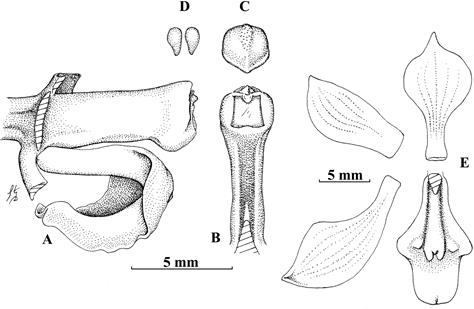
A. Column and lip lateral view.
B. Column ventral view.
C. Anther cap dorsal view
D. Pollinia, without stipe and viscidium.
E. Dissected flower.
Drawn from H. Smith 2351 (K) by Stig Dalström, with kind permission from the keeper of the herbarium at the Royal Botanic Garden, Kew.
Figure 6 Cyrtochilum schmidt-mummii.
The presence of purported silica bodies in the floral segments of C. schmidt-mummii is an interesting observation, but a more detailed discussion about this phenomenon is beyond the scope of this present paper and is better left for a future project when more plant material has been examined.
Acknowledgments
The authors thank the staff and administration of the Herbario Nacional Colombiano COL of the Instituto de Ciencias Naturales, and particularly the curator of the herbarium, Julio Betancur, and the director of the herbarium, Jaime Uribe, for their kind support and permission to examine herbarium specimens and use photographs of the type specimen in this article. We thank Peter Wüllner and Juan Felipe Posada for publishing the book with Helmuth Schmidt-Mumm’s illustrations, and we thank Phillip Cribb, the keeper of the herbarium at Kew in 1998 for allowing critical studies of preserved material. Finally, we thank Wesley Higgins for commenting on and improving the manuscript.












 uBio
uBio 
